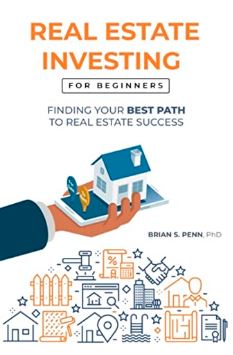Everybody wants to get into real estate. But most people don’t know how. That’s why I wrote the book, “Real Estate for Beginners: Finding Your Best Path to Success.”

My book mostly covers the different types of real estate investing that are possible. But if you’ve decided to buy a rental property, here are some steps you should consider.
Step 1 – Determine the property type
What kind of property do you want to invest in, i.e., single-family, multifamily, or storage units? This is critical because it will determine where you will be investing and drive a lot of where your efforts will go.
Step 2 – Determine your market area
Where are you going to invest? Usually, your local area is the best place to start because you are most familiar with it. You know the good neighborhoods from the bad ones. Once you have an idea of where you want to invest, do some investigating. Good places to start are Realtor.com and Zillow.com. Now, if you find out that the prices are too high or in limited supply, you may need to invest far away. Investing far away comes with its own set of headaches. A good resource for investing far away is “Long-distance Real Estate Investing” by David Greene.
Step 3 – Get Pre-approved financing
This is an interesting step. It’s perhaps superfluous if you don’t have some basic requirements:
- A W-2 job;
- Good credit; and
- 20-25% down!!
Unfortunately, lots of folks don’t have these. If you don’t, maybe the best idea then is owner-financing or taking over someone’s note. I describe how I take over people’s mortgages (legally!!) in my book.
Step 4 – Learn how to analyze properties
Analyzing properties has many facets. Here are a few questions to ask:
- Is the property in your area of interest?
- What kind of repairs are needed?
- How is the rental market in the area?
- Will a property’s rent can cover the mortgage payment (or at least break even?)
These are just very high-level aspects you should investigate, there are lots more.
Step 5 – Look for properties
I like to drive around the areas I’m interested in. Look for “For-Sale-By-Owner” signs. Yes, they are starting to appear again. Over the last several years, people’s equity has increased so fast, there was never a reason to try and sell a property without a realtor. This is starting to change as interest rates have skyrocketed with no end in sight.
There are other resources, too. I got a tip from my accountant about properties in an expensive area in Colorado. I bought a lot, put a house (trailer) on it, and made enough money to get two other properties.
As mentioned above, you can start online with zillow.com and realtor.com. For Zillow, put in your criteria and area of interest.
Last, but not least, I’ve had success by becoming close with a real estate agent. More often than not, they will have a good feeling about the type of property you’re interested in. And, if you treat them right, they will keep supplying you with deals.
Step 6 – Start analyzing a lot of deals
This is the education process. Look at as many different deals as you can. You’ll learn to recognize good ones. Make sure that you can cover the mortgage. Try to make sure your property cashflows.
Step 7 – Make an offer
This is one of the hardest steps. Lots of would-be investors get stuck on the last step and never make an offer. Yes, you’re going to get turned down. A lot. You have to get over this. If you make 3 legitimate offers/week, you’ll have more than enough good opportunities.
Step 8 – Do your due diligence
Inspect the property. Check with your insurance agent and have them look at the property, too. Hire a professional property inspector. They’ll go through the property with a fine-toothed comb. They’ll find stuff that you never thought to look at. That’s their job. If they find something, take it back to the seller. Negotiate a lower price or have them fix it.
Here are a couple more things you line up, too:
- A Title company
- Get a real esate Attorney
- Veryify rents/expenses
- Depending on your situation, a property manager
That’s all there is to it.
The eight steps outlined here are just the basics. There are nuances to almost every step, but you should get the drift. I cover a lot of this in my book, but you can also learn a lot by attending local real estate investor meetings.